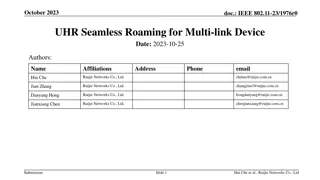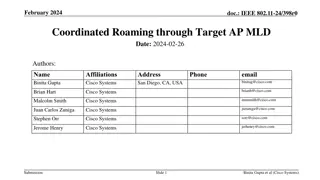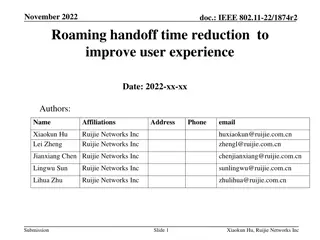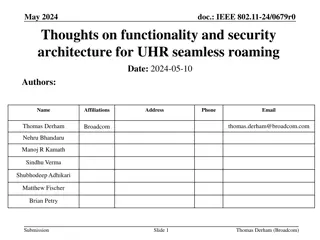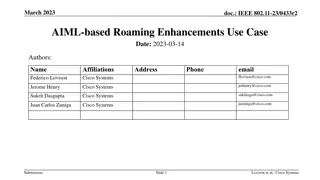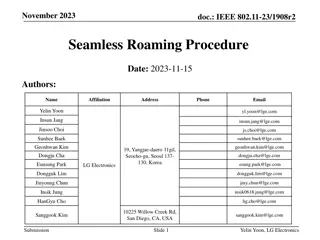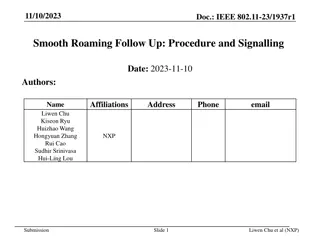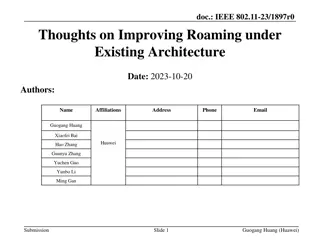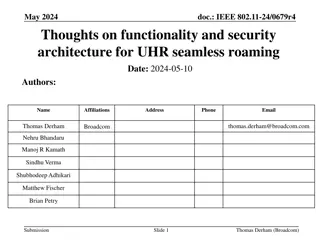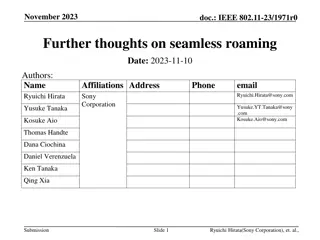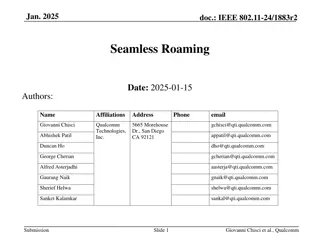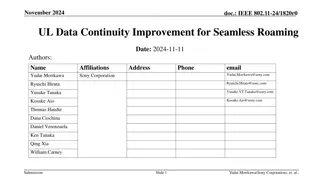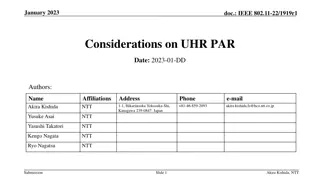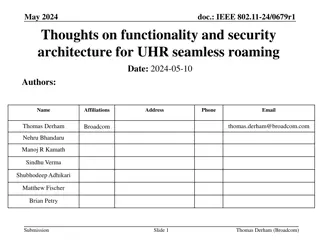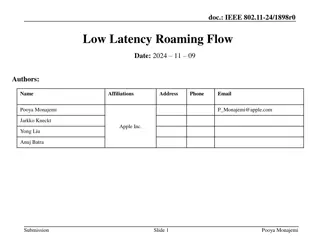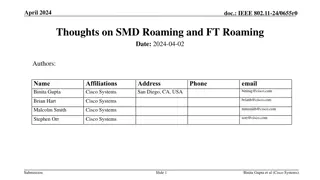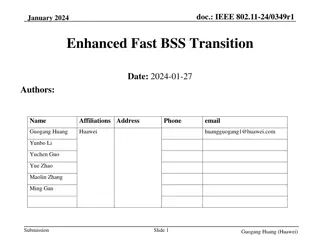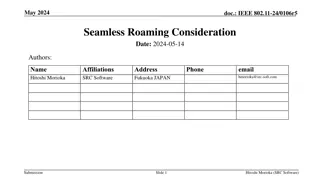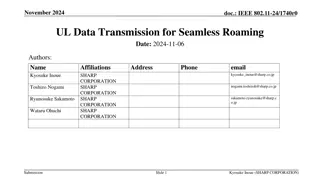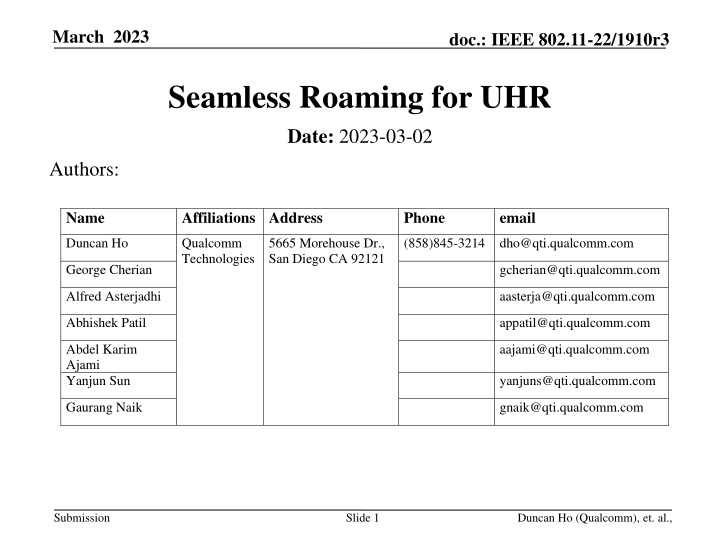
Enhancing Seamless Roaming for Ultra-High Reliability (UHR) in IEEE 802.11
Explore the improvements in mobility support for applications requiring low-latency and high reliability with IEEE 802.11-22/1910r3. This document discusses the challenges with current roaming methods, considerations for a solution, and an example solution using the 11be MLO framework. Learn about creating a seamless transition between access points to minimize data interruption and delay during handovers.
Download Presentation

Please find below an Image/Link to download the presentation.
The content on the website is provided AS IS for your information and personal use only. It may not be sold, licensed, or shared on other websites without obtaining consent from the author. If you encounter any issues during the download, it is possible that the publisher has removed the file from their server.
You are allowed to download the files provided on this website for personal or commercial use, subject to the condition that they are used lawfully. All files are the property of their respective owners.
The content on the website is provided AS IS for your information and personal use only. It may not be sold, licensed, or shared on other websites without obtaining consent from the author.
E N D
Presentation Transcript
March 2023 doc.: IEEE 802.11-22/1910r3 Seamless Roaming for UHR Date: 2023-03-02 Authors: Name Affiliations Address Phone email Duncan Ho Qualcomm Technologies 5665 Morehouse Dr., San Diego CA 92121 (858)845-3214 dho@qti.qualcomm.com George Cherian gcherian@qti.qualcomm.com Alfred Asterjadhi aasterja@qti.qualcomm.com Abhishek Patil appatil@qti.qualcomm.com Abdel Karim Ajami Yanjun Sun aajami@qti.qualcomm.com yanjuns@qti.qualcomm.com Gaurang Naik gnaik@qti.qualcomm.com Submission Slide 1 Duncan Ho (Qualcomm), et. al.,
March 2023 doc.: IEEE 802.11-22/1910r3 Problem Statement UHR is aiming for providing better support for applications that require low-latency with high reliability. One area to enhance is mobility support Currently, when the STA roams between multiple APs, the STA needs to re-associate with the target AP and perform 4-way handshake, typically taking 10s of ms The network needs to switch the data path in a break- before-make manner, which creates data interruption and extra delay during handover Submission Slide 2 Duncan Ho (Qualcomm), et. al.,
March 2023 doc.: IEEE 802.11-22/1910r3 Current Roaming When the link with AP1 deteriorates and the signal with AP2 grows stronger, the STA roams to AP2 (another case is network-directed roaming using the BSS Transition Mgmt to trigger roaming) The STA performs: Reassociation Security BA sessions re-establishment, etc. The network performs: Switching the data path between the gateway and the AP from AP1 to AP2 The above steps create a delay of 10s of ms Backhaul AP 1 AP 2 STA STA Submission Slide 3 Duncan Ho (Qualcomm), et. al.,
March 2023 doc.: IEEE 802.11-22/1910r3 Considerations of Solution Should be simple E.g., Rely on existing frameworks as much as possible Should be flexible To cover different use cases such as home, enterprise, warehouse, etc. Should be scalable To support mobility within a network consisting of large number of APs Submission Slide 4 Duncan Ho (Qualcomm), et. al.,
March 2023 doc.: IEEE 802.11-22/1910r3 An Example Solution The 11be MLO framework already allows a non-AP MLD to switch links with minimal signaling overhead and delay E.g., by making the non-collocated APs as affiliated APs of a single AP MLD (see next slide) This approach would enable seamless transition to another AP with no (or minimal) communication interruption by allowing make-before-break data path switch Submission Slide 5 Duncan Ho (Qualcomm), et. al.,
March 2023 doc.: IEEE 802.11-22/1910r3 Example Topology Reuse MLO architecture, allowing non-collocated APs to be affiliated with the AP MLD AP MLD (logical entity, physically could be co-located with any of theAP below for each client) Data path Router Affiliated APs (non-collocated) AP3 APn AP1 AP2 STAx STAy Note: SN/PN assignment, encryption are still performed at each AP inline with the existing MLO architecture Submission Slide 6 Duncan Ho, Qualcomm Incorporated
March 2023 doc.: IEEE 802.11-22/1910r3 Transition Steps 1. Before transition STA is active with AP1 Data path is routed to AP1 AP1 hosts MLD context for the client 2. During transition STA is active with both AP1 and AP2 AP1 duplicates/forwards packets to AP2 (optional) Both AP1 & AP2 sends packets to client independently (optional) 3. After transition STA is no longer active with AP1 Data path re-routed to AP2 AP2 keeps the MLD context for the client AP MLD (logical entity) 3 Router Data path 1 2 Affiliated APs AP 2 AP 1 (non-collocated) 2 STAx STAx MLD Association (auth, assoc., BA context etc.) is maintained during transition from AP1 to AP2 Submission Slide 7 Duncan Ho, Qualcomm Incorporated
March 2023 doc.: IEEE 802.11-22/1910r3 Conclusion We introduced the problems of roaming and presented a simple, flexible, and scalable example solution Submission Slide 8 Duncan Ho (Qualcomm), et. al.,
March 2023 doc.: IEEE 802.11-22/1910r3 Updates since the IEEE meeting in November 2022 (Bangkok) with Q&A follow-up Submission Slide 9 Duncan Ho (Qualcomm), et. al.,
March 2023 doc.: IEEE 802.11-22/1910r3 Further Discussion on AP MLD A different kind of AP MLD (upper and lower MACs)? The main functionalities of the AP MLD remain the same as defined in 11be Maintains the context of association, security, BA sessions, etc Is the AP MLD moving when the client roams from one AP to another AP? No, all the APs that enable seamless roaming experience are expected to be affiliated with the same AP MLD Only the context and (physical) MAC-SAP are moving (following the non-AP MLD) Submission Slide 10 Duncan Ho (Qualcomm), et. al.,
March 2023 doc.: IEEE 802.11-22/1910r3 SMD AP MLD Logically X + Y1 + Y2 = Single Mobility Domain AP MLD (SMD AP MLD) Functionalities can be implemented at different locations no restrictions (flexible enough to allow different backhaul architectures) Note: X can be implemented inside Y1/Y2 Association, BA, security, SN/PN, encryption, etc. X Y1 Y2 Colocated set manager: AID, Link ID, group addressed delivery, etc. S1 S2 Submission Slide 11 Duncan Ho (Qualcomm), et. al.,
March 2023 doc.: IEEE 802.11-22/1910r3 Comparison between AP MLD and SMD AP MLD Functionalities AP MLD SMD AP MLD (for UHR clients that support seamless roaming) Affiliation of APs All affiliated APs are colocated Not all affiliated APs are colocated Authentication, association context, security context, BA sessions, SN/PN maintenance, encryption of unicast frames Done at the Upper MAC sublayer (i.e., AP MLD) Same (i.e., at the upper MAC sublayer of SMD AP MLD) AID, Link ID Scope is per AP MLD One AID per assoc Scope is per colocated set. Optionally > 1 AID per assoc (when concurrent non- colocated links is supported by the backhaul) Group addressed frames delivery Done at the Lower MAC sublayer Same (confined within the colocated set) Submission Slide 12 Duncan Ho (Qualcomm), et. al.,
March 2023 doc.: IEEE 802.11-22/1910r3 Operation of Different Types of Non-AP MLDs Functionalities EHT non-AP MLD/UHR non-AP MLD that does not support SMD UHR non-AP MLD that supports SMD (Re)Association Always with an AP MLD Always with an SMD AP MLD Roaming between non- colocated APs Always between AP MLDs. (re)Assoc required. New PTKs, BA sessions, security context re- established No (re)Assoc. Uses ML Reconfig to add/remove APs. PTK, PN/SN, BA sessions, security context are maintained and not reset (completely transparent to the non-AP MLD) The non-AP MLD is served by Only the colocated APs affiliated to the same AP MLD Colocated APs and (optionally) non- colocated APs affiliated with the SMD AP MLD AID assignment One AID per collocated AP set One AID per collocated AP set. If client is served by more than one collocated set concurrently (optional), then client identified via a tuple - (Colocated set ID, AID) Link identification Link ID (Colocated set ID, link ID) tuple Submission Slide 13 Duncan Ho (Qualcomm), et. al.,
March 2023 Different Types of Non-AP MLDs doc.: IEEE 802.11-22/1910r3 X Y1 Y2 AP MLD Assoc, BA sessions with X S2= UHR non-AP MLD that supports SMD S1=EHT non-AP MLD or UHR non-AP MLD that does not support SMD S1 S2 Submission Slide 14 Duncan Ho (Qualcomm), et. al.,
March 2023 Before Transition (logical perspective) - Link 2 is inactive doc.: IEEE 802.11-22/1910r3 IEEE 802.1X MAC SAP MLD Upper MAC Sublayer MAC Sublayer Management Entity MAC Sublayer Management Entity MLD Lower MAC Sublayer MLD Lower MAC Sublayer PHY SAP PHY SAP MLME-PLME SAP MLME-PLME SAP PHY PHY Management Entity PHY PHY Management Entity Link 2 (non-colocated with Link 1) Link 1 Submission Slide 15 Duncan Ho (Qualcomm), et. al.,
March 2023 During Transition (logical perspective) - Both links are active doc.: IEEE 802.11-22/1910r3 IEEE 802.1X MAC SAP MLD Upper MAC Sublayer MAC Sublayer Management Entity MAC Sublayer Management Entity MLD Lower MAC Sublayer MLD Lower MAC Sublayer PHY SAP PHY SAP MLME-PLME SAP MLME-PLME SAP PHY PHY Management Entity PHY PHY Management Entity Link 2 (non-colocated with Link 1) Link 1 Submission Slide 16 Duncan Ho (Qualcomm), et. al.,
March 2023 doc.: IEEE 802.11-22/1910r3 During Transition (Physical perspective) - Both links are active IEEE 802.1X MAC SAP MLD Upper MAC Sublayer MLD Upper MAC Sublayer MAC Sublayer Management Entity MAC Sublayer Management Entity MLD Lower MAC Sublayer MLD Lower MAC Sublayer PHY SAP PHY SAP MLME-PLME SAP MLME-PLME SAP PHY PHY Management Entity PHY PHY Management Entity Link 2 (non-colocated with Link 1) Link 1 Submission Slide 17 Duncan Ho (Qualcomm), et. al.,
March 2023 doc.: IEEE 802.11-22/1910r3 Further Discussion on Scaling How does scaling work with many APs? Only a handful of APs (in the vicinity of the STA) need to be aware of the STA s presence and ready for roaming The STA only needs to learn the presence of those APs (but need not have all those APs as setup links) Submission Slide 18 Duncan Ho (Qualcomm), et. al.,
March 2023 doc.: IEEE 802.11-22/1910r3 Further Discussion on Link ID Concern raised: how to signal so many links since the current link ID is only 4 bits Answer: In a lot of cases (e.g., home network) the current link ID is enough When needed, we may extend the Link ID. One example is to define a Colocated set ID as follows: E.g., a floor has 100 11be physical APs, one collocated ID is assigned to each AP (collocated ID = 1, 2, 100) Note this is different than the AP MLD ID, which is the id of a specific AP MLD in a physical AP, which can host multiple AP MLDs (e.g., one for Home users and one for Guests) Define an Extended link ID as the tuple (Colocated set ID, link ID) Submission Slide 19 Duncan Ho (Qualcomm), et. al.,
March 2023 doc.: IEEE 802.11-22/1910r3 Further Discussion on AID Consider expanding AID space, even for baseline (good for IoT scenarios) If keeping the same AID space, one option isto assign the client one AID per Colocated set Colocated set contains the affiliated APs that are located at the same physical AP that are used to serve the non-AP MLD (via a single MAC-SAP) Need to specify the Colocated set where this new AID applies A client can be assigned a list of (Colocated set ID, AID) depending on its location Submission Slide 20 Duncan Ho (Qualcomm), et. al.,
March 2023 doc.: IEEE 802.11-22/1910r3 Further Discussion in Duration Duration of using multiple APs? No limitations but ideally short (10s of ms) to enhance reliability with minimal load impact to the network Submission Slide 21 Duncan Ho (Qualcomm), et. al.,

